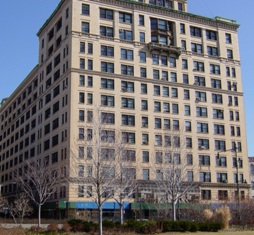City Moves to Landmark Artist Commune Westbeth and Union League Club
By Tom Acitelli October 20, 2009 7:25 pm
reprints The city’s Landmarks Preservation Commission on Tuesday took the first step toward landmarking Westbeth, the first subsidized artists’ housing in the United States and where television and radar were invented, and the Union League Club, whose members included J.P. Morgan, John Jay and Teddy Roosevelt.
The city’s Landmarks Preservation Commission on Tuesday took the first step toward landmarking Westbeth, the first subsidized artists’ housing in the United States and where television and radar were invented, and the Union League Club, whose members included J.P. Morgan, John Jay and Teddy Roosevelt.
Westbeth, at 463 West Street, is a five-building complex that was the historic telecommunications laboratory of Bell Telephone Company, part of AT&T. The complex was built in various stages, beginning with a wood mill in 1861. Factories for Western Electric Company, the manufacturing branch of AT&T, were built at the turn of the 20th century and the laboratories were designed in the 1920s, according to the LPC.
From 1899 to 1966, AT&T occupied the complex, and researchers invented the transistor; a device that brought sound to movies; radar; and television.
From 1978 to 1970, the entire complex was converted to artists’ residences, with architect Richard Meier designing 383 studio units. Roger Stevens, the first chairman of the National Endowment for the Arts, conceived the complex as the largest government-subsidized artists’ colony in the world, the first low-cost housing of this kind in the United States.
Last month, the federeal government sold the mortgage on Westbeth to the city’s Housing Development Corporation, but the 384 current residents were not affected.
Preservationists have been calling for the landmarking of Westbeth for years.
The Union League Club, at 38 East 37th Street, was completed in 1931 and designed by architect Benhamin Wistar Morris, who also designed the Bank of New York. It is the fourth home of the organization, which was founded in 1863 to support President Lincoln’s efforts to preserve the union. Its members helped to establish the Metropolitan Museum of Art in 1870 and the American Red Cross, according to its Web site.
The building includes a dining and gathering space, fitness center, lodging and library. The site was purchased from J.P. Morgan, whose landmark library is nearby.
Both properties were expected to officially begin the landmarking process with a vote by the LPC’s board Tuesday, an action known as calendaring. Almost every building that is calendared ultimately receives landmark designation, which restricts development of the buildings.
rli@observer.com


